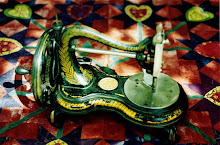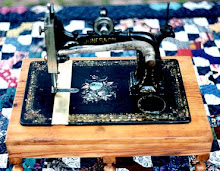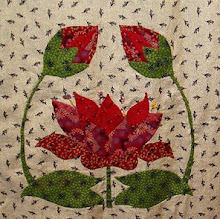
This a very special Singer model 12 which is absolutely covered in Mother of Pearl Inlay and Gold decals.


Everywhere you look there are decals and inlay even around the edge of the bed. If you enlarge the photos you will see that even the plates have designs etched onto them.


I do see where George Ross McKenzie was one of Singers Presidents in 1882. Maybe? The Kate McKenzie name is a name which seems to have been lost in history. If anyone has any theories or documented information of the Kate McKenzie,the owners of this machine as well as many sewing machine enthusiasts would be thrilled to hear.
 Even the flywheel and treadle plate are covered in decals.
Even the flywheel and treadle plate are covered in decals. 
This Gorgeous Machine is a Singer 12K. In the Centre of the Bed are the words Kate McKenzie 1879. The Mother of Pearl is absolutely Stunning and her decals are rich and glorious. Every part of her is heavily decaled as you can see. Her Walnut Veneer is stunning. She is a truly Stunning machine and like I said a privilege to see in real life.
Cheers Rob and Lynne




21 comments:
I found some info about your Mother of Pearl machine. See the article below. Seems to be a popular decorated machine called the Letter A, made from 1858 - 1865.
CONTEMPORARY COLLECTIBLES LINDA ROSENKRANTZ
Old sewing machines are still hot
February 27, 2005
Collectors now treasure those early models for their fine workmanship and often-elaborate design elements. The name most commonly associated with this appliance is Singer, even though Isaac Merritt Singer did not invent the sewing machine. Elias Howe Jr. is given the credit for that, though there were several earlier versions of the invention, including a simple device produced by a French tailor named Thimmonier in 1830.
Howe was granted a patent in 1846 for a machine that executed 250 stitches a minute, but had several major flaws. A few years later, Singer, a flamboyant and ambitious machinist, inventor and touring Shakespearean actor, saw some of these often-malfunctioning machines in a factory and was determined to make some improvements.
After only 11 days of experimentation, Singer produced a machine that could run continuously, that used a straight needle that moved up and down (Howe's had been curved) through the cloth, and had a foot-operated treadle instead of a hand crank. This led to an extended court battle between Howe and Singer, with the result that Howe received a royalty on every sewing machine sold.
In addition to his mechanical advances, Singer was also a pioneer in business practices, particularly in the area of franchising. The Singer Machine Combination sold licenses to manufacturers for a one-time franchise fee, which was divided among the patent holders.
Another innovation was the Hire-Purchase Plan, which permitted buyers to take home the expensive product for a $5 down payment, as was his pioneering system of providing service and his "liberal plan of exchanging Singer's new and latest improved sewing machines for old or unimproved sewing machines of every kind."
Singer's acting background came in handy when he toured the country giving dramatic recitations and displays of his mechanical marvel. He was a man who thought globally, spending millions of dollars on advertising, with the result that his brand was known worldwide by 1900.
Like other machines of the day, the Singers were often quite ornate and baroque in design. An early example is the Turtleback, which came in a cabinet model with cast iron top and wooden sides, painted with flowers, and another enhanced with swirling metal vines.
Another desirable model is the Letter A, which was made from 1858 to 1865 in several variations, including one with mother-of-pearl inlay, and another with an unpainted walnut cabinet.
Other major models were the Singer New Family, introduced in 1865, some of whose heads were embellished with elaborate mother-of-pearl and gilt designs – more than 4 million of this model were sold – and the Singer Automatic, some of which had unusual brass legs supporting their fine, gold-decorated cabinets.
The newly released second edition of "The Encyclopedia of Early American Sewing Machines" by Carter Bays (Collector Books) offers a comprehensive picture of this significant machine from its earliest invention to the end of the 18th century, with detailed histories of such innovators as Howe and Singer, information on the major manufacturing firms and the rarity and value of their products, a section on toy sewing machines, and detailed information on restoration.
________________________________________
Linda Rosenkrantz edited Auction magazine and authored nine books, including "Baby Books Now."
© Copley News Service
Here is more of the article, the blog would only allow so many words.
---------------------------------
Other major models were the Singer New Family, introduced in 1865, some of whose heads were embellished with elaborate mother-of-pearl and gilt designs – more than 4 million of this model were sold – and the Singer Automatic, some of which had unusual brass legs supporting their fine, gold-decorated cabinets.
The newly released second edition of "The Encyclopedia of Early American Sewing Machines" by Carter Bays (Collector Books) offers a comprehensive picture of this significant machine from its earliest invention to the end of the 18th century, with detailed histories of such innovators as Howe and Singer, information on the major manufacturing firms and the rarity and value of their products, a section on toy sewing machines, and detailed information on restoration.
________________________________________
Gorgeous machine. Wonderful it has suvived the time it has been around.I was an employee of The Singer Company and it is a pleasure to view this set of pictures. You have a treasure. Chris
Are you the owner of the machine? I wasn't sure if you were just showing pictures of a machine or it is yours. It is gorgeous. Looks like something Cleopatra would sew on with all the gold design. A machine like this must cost a lot of money if you can find one.
This is a fascinating search. It seems, if this is the same machine listed in the article below, that it could have come from America to Australia, which opens up many Kate (Catherine, Katherine) McKenzies.
ISMACS Australasia Incorporated
2NEWSLETTER Oct 2006
“Kate McKenzie”
by Coral Howe, Latrobe Tasmania
This sewing machine first came to our attention about ten years ago, when a elderly local chap who had once worked for the Singer Company, in America, told us he had a machine he thought we may like to have a look at. He said it was not for sale, and that it was down the back in his shed. About eighteen month later, he told us that we could see it. A day was set the following week, when we arrived we were invited in for a cuppa and a chat, then, it was off to the shed. Eric and the elderly chap hunted through an assortment of pre-loved items, to find the
machine.
“Kate McKenzie” we call her, she was not quite as good looking on the outside as she is now, but when we lifted the cover, there was this lovely machine, abet grubby, but no less lovely. After chatting awhile, the elderly chap said, “Do you want it?” then he told us his price, and needless to say, the machine went home with
us that day. He also told us he had bought it at auction some twenty years before, at a place called Hagley. As you can see the machine is a fiddle base Singer No 551000, is completely covered in gold decals and mother of pearl.
The needle plate is filigreed, and there is a decal in the centre of the bed with the words “Mrs. Kate McKenzie 1879”, we don't know who
Kate McKenzie was but would like to know if anyone can help us.
There was a hand written note in a draw of the machine cabinet, which I will add (spelling mistakes and all).
“Nan Bickford’s parents (or Grandparents)Johnson of Melbourne. Charted Accountant. Had been educated in Germany. The family
were wealthy cotton spinners of Leeds. (Matthew Johnson and sones) Emily Mary Littlewod, his wife-also cotton spinning family,
came out to Melbourne and married him, aged 23 years, after a voyage of six month by sail. The furniture being taken from the ship by bullock wagon bogged down in Collins Street (about 1852) lived at Northcote, then the
fashionable suburb.”
I have copied this word for word, I don't know what it has to do with this machine, if anything, but if anyone can shed some light on this family, please contact the Secretary – ISMACS Australasia Incorporated – who will contact us.
Looking at this beauty...all I can say is, "My, oh my"!
Hi All
I wish that this machine was ours :-)
Sadly it is not. It is definately a Singer 12 and we saw her on our Travels. A photo of this machine/decals is not in any Carter Bays book. His machines are American and this machine is English. Even the Drawing Room Cabinet is different. She actually belongs to friends of ours and this was the first opportunity that we had had to photograph her and with permission put her on the blog. She is spectacular and even better in real life.
Cheers
Lynne
WOW!!! What a beauty. Like everybody else I wish she was mine!!! Great post thanks for sharing this with us. Cheers Sharron
Oh my! This is an absolutely stunning machine!
This machine is almost like a piece of jewelry...amazingly beautiful!
Thank you for sharing it with us!
I really have never seen a more beautiful sewing machine!!!!!!
Just gorgeous!!!
I also would love to hear more about this "Kate McKenzie"; and why her name is on this machine.
Hope you can find it out!
Wowza! Glue a pin back on that baby and wear her. Sparkly!
so heavily covered in decals that I would not even use this machine as I would be afraid to damage it.
this singer 12 would be in a under a glass cover and used for display only...
so very beautiful
I loved looking at your blog. Such Beautiful machines. To bad new machines are not this beautiful.
What a stunning machine! wow!
That's just gorgeous! Amazing...
Oh my gosh, this is over the top fabulous. I'm a sewing enthusiast and would love to place one of the photos on my blog that will link to your post..would that be ok?
It's just so beautiful I'd like to see it everyday. :0)
If you don't mind come over to my blog and let me if I have permission to post a photo of it with a link back to you.
Have a lovely day,
Stephanie ♥
¡ que maravillas ! Felicidades por esa maquina tan preciosa.
That machine makes my heart sing, it is stunning
cheers
Christine
That machine makes my heart sing, it is stunning
cheers
Christine
Post a Comment